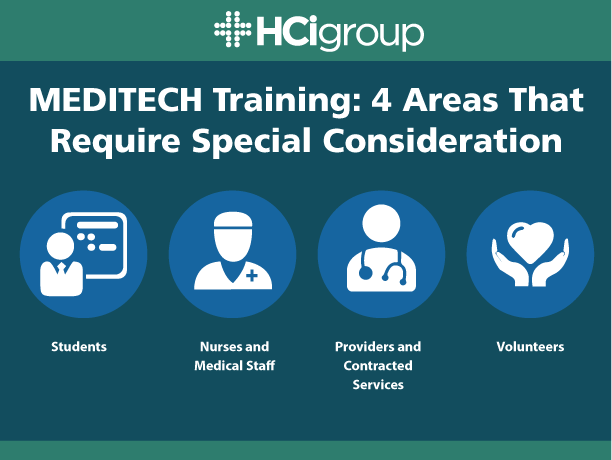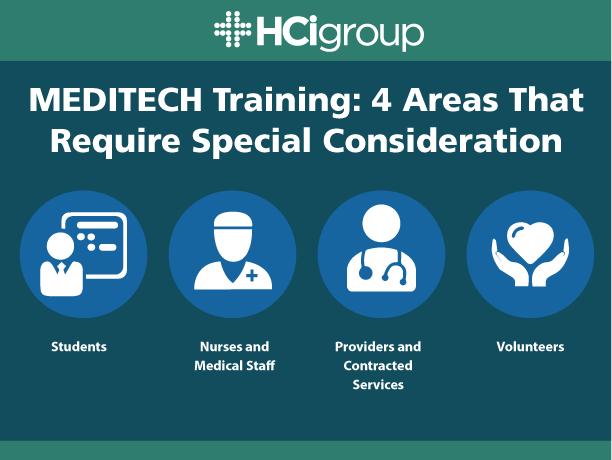MEDITECH Training: 4 Areas That Require Special Consideration


Training is one of the most important and pivotal aspects to the implementation of your MEDITECH EMR, and it will go a long way to determine the success of your project as a whole. In this post, The HCI Group’s Executive Vice President Bob Steele takes a look at some unique opportunities to meet the needs of often overlooked end user needs in order to ensure success during your MEDITECH training project.
1) Cycling Students during MEDITECH Training
One of the largest groups that will require some unique planning is students, whether you’re an academic institution or you just have a frequent amount of people rotating through the organization. A number of challenges arise due to this; students can change and rotate out as often as every 4-6 weeks or as often as every semester. Commonly in the marketplace today, July is the induction month for the arrival of new medical students and residents at institutions. Due to their rapidly changing schedules and unique needs, it can be challenging for your organization to get them the training they need. For this reason, it is imperative to work closely with educational institutions with whom students are associated with at your institution to design and plan a process to support this need. Some common practices that can help achieve this include:
- Utilization of remote training via options such as Web-Ex, E-Learning and self-study modules. These will allow students to be able to complete training at times and places that are most convenient for them.
- “Train the Trainer” for identified program/school faculty. This will support both your organizational needs and promote both partnership and autonomy for the scholastic partner.
- Incorporating students in monthly or routine orientation and training sessions. By following this practice you give more times and opportunities in which students can receive training.
Design and development of training classes, condensed and specific to the individual needs of the student’s planned educational experience based on area of practice. This makes sure that students save time and get training specifically tailored for their individual roles.
2) MEDITECH Training for Nurses and Other Medical Staff
This frequent and ongoing rotation cycle is also seen during training for nurses, who are the next largest group, and can be cycled as frequently as every quarter depending on educational goals. In addition to nurses, there are other groups of individuals who will need training within the new MEDITECH system:
- Paramedical
- Lab
- Radiology
- PT/OT/Speech
- Respiratory Therapy
- Dietary
For all of these groups, it is important to make sure that you have a plan in place in order to offer the training that is important to them – so that they can function in their educational realm within your institution.
3) Providers and Contracted Services
The thing to remember about this group is that they most often are not hospital employees and have challenging and demanding schedules. Training efforts and schedules need to ensure flexibility and availability during some "non-traditional" times in order to make sure that everyone can receive the training that they need. Evenings, weekends, and maybe even night shifts are times that must be considered in order to accomplish this. An important aspect of adoption, sustainment and satisfaction comes from first impressions, and if your MEDITECH training project offers enough variety in type and schedule, it will be perceived as less of a constraint to the “day in the life” of these groups.
4) Volunteers
Often known as the frequently forgotten group, volunteers are an important group of people who should be appreciated and valued. Organizations would be very hard pressed to function fully without the help of volunteers, and it is not uncommon that the first person someone meets when they walk into a hospital is a volunteer at the information desk or entrance, helping direct you where you need to go. They will need to be able to get into the MEDITECH system to locate patients, department needs and schedules, and they are great PR for your patients as they can help to make both their lives, as well as the patient’s families lives, much easier.
A rule that an organization should consider adhering to is the idea of “no training, no sign-on.” Following this rule will help to minimize errors and ensure that your entire staff, from top to bottom, is knowledgeable of your new MEDITECH system. For this reason, it is imperative that your organization has a plan in place to ensure that these resources – from students, to nurses and other clinicians, to providers, to volunteers – receive the special considerations that they need prior to implementing MEDITECH.
Additional Resources You May Be Interested In
- eBook: The Definitive EHR Go-Live Guide
- Go-Live Support: Training and Super-User Support
- Go-Live Support: Pre & Post Go-Live Planning
- Go-Live Support: Operation Communication

